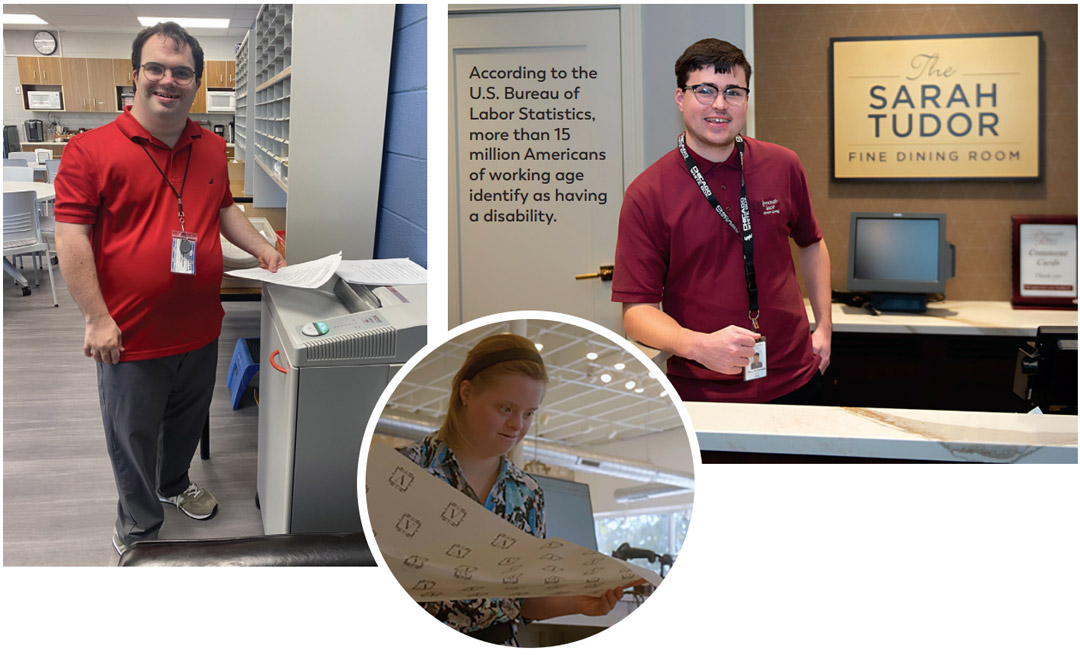
Working Together Chicago: Breaking Down Employment Barriers for Young Adults Living with Disabilities
In 1987, Justin Herbst was born ten weeks premature, and suffered a severe stroke. This led to a diagnosis of cerebral palsy–spastic quadriplegia, a permanent neuromuscular disorder and the most severe form of CP, limiting the ability to move the limbs, torso and face.
Despite his diagnosis, Herbst’s mom Patti believed her son could become independent. A decade later and frustrated by a lack of improvement in the traditional medical therapy model, Herbst’s parents enrolled him in a Canadian program focused on conductive education. Conductive education is a comprehensive method of learning, through which individuals with neurological and mobility limitations gain the ability to specifically and consciously perform actions that children without CP learn naturally as they develop.
After five intensive weeks in the program, Herbst learned to sit independently at the age of 10. The experience changed his life and his mother’s vision for children like himself. The program also gave Patti Herbst the evidence and tools to prove children with physical disabilities could develop new pathways for movement, given the opportunity.
Committed to sharing this approach with other families, Herbst and her husband Chuck channeled their energy into founding the Center for Independence through Conductive Education in 1998. The mission of the center is to help children and adults with disabilities achieve their highest level of independence in the home, community, school and workforce. The organization began by serving six children with physical disabilities. Today, they serve more than 350 children and young adults at three locations across the Chicagoland area, including Countryside.
“We are proud to be celebrating our 25th anniversary this year,” said Herbst, who serves as executive director for the center. The center’s conductive education program is delivered in a transdisciplinary model, with physical therapists, occupational therapists and conductive education teachers all working together to deliver a comprehensive intensive motor training program.
The center also has employment specialists and job coaches in its job placement program, Working Together Chicago. This program places young adults with varying disabilities in jobs throughout the Chicagoland area, providing support through job development, networking, short-term coaching and long-term mentoring. They create paid employment opportunities for people with disabilities, and promote a diverse, equitable and inclusive workforce. Participants work anywhere from eight to 30 hours a week, depending on the nature of their disability and their healthcare needs.
Working Together Chicago began in 2016 due to a gap in services.
Justin Herbst graduated from the center’s intensive motor training program, and attended regular education classrooms from kindergarten through high school. He went on to enroll at Southern Illinois University, and graduated with a degree in history. “Our staff was so thrilled,” Patti Herbst said. “That’s our objective: to get these kids out into the community, and get them to college; but when Justin came home, he couldn’t find a job.”

Working Together Chicago was established to help young adults like Justin Herbst with job placement. As the center’s participants grew into adulthood, the organization became painfully aware of the barriers people with disabilities face in accessing the workforce, and expanded its services to include employment placement through the Working Together Chicago program.
More than 15 million people of working age in the U.S. identify as having a disability, according to the U.S. Bureau of Labor Statistics. Despite the passing of the Americans with Disabilities Act more than 30 years ago, the Society for Human Resource Management reports that the unemployment rate for individuals living with a disability is twice as high as the unemployment rate for individuals without a disability. Barriers to employment for disabled individuals can include conscious and unconscious discrimination, transportation, fear, lack of experience and even limitations due to the use of artificial intelligence in the interview process.
Working Together Chicago believes the way to bridge the current employment gap is by collaborating across sectors with the common goal of generating new approaches that reimagine what is possible.
Patti Herbst said hiring people with disabilities does not increase insurance liability or workman’s compensation insurance rates, and the vast majority of workforce accommodations are less than $500. People with disabilities also tend to stay with an organization longer.
“People with disabilities bring great value to the workforce,” Herbst said. “They are highly motivated to work. Top recruits want to work for inclusive employers, and customers of inclusive employers are more satisfied and loyal.”
Today, Justin Herbst is living independently in La Grange, and is employed at a job he loves at local non-profit BEDS Plus.
Like Herbst, Terry McDermott received assistance through Working Together Chicago. McDermott’s mom Anne learned about the program through friends, and turned to it to begin looking for a new job for her son last winter. Working Together Chicago helped him develop the skills he needed to work on his resume, apply for a job and interview.
Charlie O’Malley, the program’s employment specialist and job coach, aided McDermott throughout the process. O’Malley helped McDermott identify opportunities that were a good fit for him, and he was hired in the food services division at Plymouth Place in La Grange Park, where he delivers meals to residents.
“Working Together Chicago helped him throughout the entire job application process,” Anne McDermott said. “They were always there to provide resources, and Terry really liked working with Charlie, who helped him acclimate and take on more and more independence in his role.”
Plymouth Place has proven to be a great fit for McDermott.
“His boss is so positive, and it makes you feel good when people are nice to him,” Anne McDermott said. “It has been a very good experience for my son. Terry enjoys it, and there are a lot of opportunities for him at Plymouth Place.”
